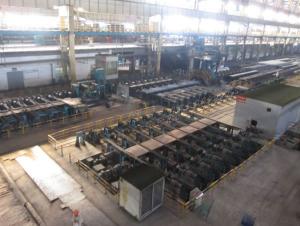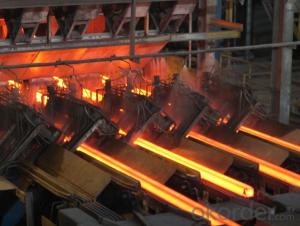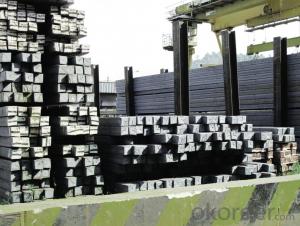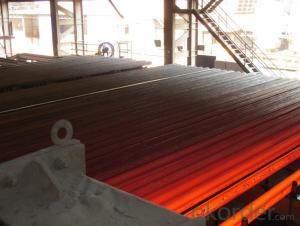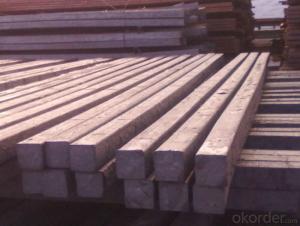Prime square alloy steel billet 90mm Q235
- Loading Port:
- Shanghai
- Payment Terms:
- TT OR LC
- Min Order Qty:
- 100 m.t.
- Supply Capability:
- 10000 m.t./month
OKorder Service Pledge
OKorder Financial Service
You Might Also Like
Structure of Prime square alloy steel billet 90mm Q235

Description of Prime square alloy steel billet 90mm Q235
1. Prepainted steel coil is coated with organic layer, which provides higher anti-corrosion property and a longer lifespan than that of galvanized or galvalume steel sheets.
2. The base metals for prepainted steel coil consist of cold rolled, HDGI Steel, electro-galvanized and hot-dip alu-zinc coated steel. The finish coats of prepainted steel coil can be classified into groups as follows: polyester, silicon modified polyesters, polyvinylidene fluoride, high-durability polyester, etc.
3. The production process has evolved from one-coating-and-one-baking to double-coating-and-double-baking, and even three-coating-and-three-baking.
4. The color of the prepainted steel coil has a very wide selection, like orange, cream-colored, dark sky blue, sea blue, bright red, brick red, ivory white, porcelain blue, etc.
5. The prepainted steel coils can also be classified into groups by their surface textures, namely regular prepainted sheets, embossed sheets and printed sheets.

Main Feature of Prime square alloy steel billet 90mm Q235
1. Thickness: ≥20μm
2. Pencil Hardness: 2H
3. 60° specular glossiness of coating: >60
4. 180°bend: ≤3T
5. Impact: ≥9J
6. Salt Fog Resistant: ≥500h
7. Color difference:<0.8δe< span="">
Applications of Prime square alloy steel billet 90mm Q235
Manufacture Progress:HRC-CRC-GALVANIZED-COLOR COATED
Application : Construction, electrical, transportation, steel plant, composite board plant, steel tile factory
Payment & Shipping Terms:T/T ,L/C, and FOB CHINA
Minimum Order Quantity: 25Tons
Packge Type: Moisture-proof paper inner,Steel outside,Bundle by steel rope.
Package in Container : Wood as a foot pad, wire rope reinforcement,PPGI steel coil tied together by steel rope.

Specifications of Prime square alloy steel billet 90mm Q235
Product | Billet |
Material Grade | SGCC / SGCH / DX51D+AZ, etc |
Thickness | 0.6-3.0mm |
Width | 500-1500mm |
Tolerance | Thickness: +/-0.02mm , Width:+/-2mm |
Zinc-coating | Z30-150g/m2 |
Technique | Raw material: Hot rolled steel coil --> Cold rolled_>hot dipped galvalume |
Surface | Dried, Chromated, Unoiled |
Spangle | Regular spangle , small spangle, zero spangle |
ID | 508MM 610MM |
Coil weight | 1-25MT |
Export package | Cardboard inner sleeves, Waterproof paper, galvanized steel covered and steel strip packed |
FAQ of Prime square alloy steel billet 90mm Q235
We have organized several common questions for our clients,may help you sincerely:
1. How Can I Visit There?
Our company is located in Tianjin City, China, near Beijing. You can fly to Tianjin Airport Directly. All our clients, from home or aboard, are warmly welcome to visit us!
2. How Can I Get Some Sample?
We are honored to offer you sample.
3. Why choose CNBM?
we always fix steel produce in container well to make it safe arrive at destination port
we always provide best and professional forward service for our buyer
we always apply 14days free detention for our buyers container in destination
we provide one set After-sales service for our buyer
we provide China inland steel market price report
we help our buyer become number one in local market .
- Q:What are the potential applications of steel billets in the oil and gas sector?
- Due to their excellent mechanical properties and durability, steel billets offer a wide range of potential applications in the oil and gas sector. Here are several examples: 1. Drill pipes and casings: Manufacturing drill pipes and casings, which are vital components in the drilling process, can be achieved using steel billets. These pipes and casings must endure high pressure and extreme temperatures, necessitating the strength and toughness provided by steel billets. 2. Pipelines: Steel billets can be utilized to create seamless or welded steel pipes for oil and gas pipelines. These pipes are responsible for transporting oil, gas, and other petroleum products across long distances. Steel billets ensure the durability and integrity of the pipelines, withstanding high pressure, corrosion, and impact. 3. Offshore structures: Steel billets are also essential in constructing offshore platforms, drilling rigs, and other structures used in extracting and producing oil and gas from offshore reserves. These structures are exposed to harsh marine conditions, including saltwater, wind, and waves. Steel billets provide the necessary strength and corrosion resistance to withstand these challenging environments. 4. Pressure vessels and storage tanks: Steel billets can be employed in manufacturing pressure vessels and storage tanks used for storing and transporting oil, gas, and various chemicals. These vessels and tanks must withstand high pressure and temperature variations without compromising safety. Steel billets offer the required strength and resistance to corrosion and leakage. 5. Equipment components: Steel billets are also used in fabricating various components and equipment used in the oil and gas sector, such as valves, flanges, fittings, and connectors. These components are crucial for the operation and maintenance of oil and gas facilities, and steel billets ensure their reliability and performance. In conclusion, the potential applications of steel billets in the oil and gas sector are extensive and diverse, covering various stages of exploration, production, transportation, and storage. Their exceptional strength, durability, and resistance to extreme conditions make them an ideal material choice for critical applications in this industry.
- Q:What are the main uses of steel billets?
- Steel billets are a crucial component in various industries, serving as semi-finished steel products. They have multiple applications, including but not limited to: 1. Steel production: Steel billets act as the starting point for manufacturing different steel products. They are used to create bars, rods, wire, and structural sections, among other steel items. 2. Construction industry: The construction sector heavily relies on steel billets for producing beams, columns, and other structural elements. These billets are often shaped and sized according to specific project requirements. 3. Automotive industry: Steel billets find use in the automotive industry for fabricating various components, such as crankshafts, camshafts, axles, and gears. These billets undergo further processing to achieve the desired shapes and sizes for these components. 4. Machinery and equipment manufacturing: Machinery and equipment manufacturers employ steel billets to create high-strength and durable parts and components like gears, shafts, and bearings. 5. Pipe and tube manufacturing: Steel billets are indispensable raw materials in the production of pipes and tubes. They are either heated and pierced to create seamless tubes or rolled and welded to manufacture welded tubes. These tubes have applications in industries such as oil and gas, construction, and automotive. 6. Forging industry: The forging industry widely utilizes steel billets to forge components like crankshafts, connecting rods, and valves. The billets are heated and shaped using pressure and heat to achieve the desired strength and shape. 7. Shipbuilding industry: In the shipbuilding industry, steel billets are employed for constructing ship hulls, frames, and other structural components. These billets provide the required strength and durability for marine applications. To conclude, steel billets are the primary raw material for manufacturing a wide range of steel products used across industries such as construction, automotive, machinery manufacturing, pipe and tube manufacturing, forging, and shipbuilding.
- Q:What is the role of steel billets in the construction of airports and terminals?
- Steel billets play a crucial role in the construction of airports and terminals due to their various advantageous properties. They are essentially semi-finished metal products that are used as a raw material in the manufacturing of different steel products. In the context of airports and terminals, steel billets are primarily utilized for the production of structural steel components such as beams, columns, and trusses. One of the key reasons why steel billets are preferred in the construction industry is their strength and durability. Steel is renowned for its high tensile strength, which allows it to withstand heavy loads and structural stresses. This makes it an ideal material for constructing large and complex structures like airports and terminals, where safety and reliability are paramount. Additionally, steel billets can be easily fabricated into various shapes and sizes, making them versatile for constructing different components required in airports and terminals. These billets are often hot rolled or forged into the desired shapes, ensuring that the resulting steel products have the necessary strength and structural integrity. Another crucial advantage of steel billets in the construction of airports and terminals is their resistance to adverse environmental conditions. Airports and terminals are exposed to harsh weather conditions, including extreme temperatures, moisture, and corrosion. Steel, especially when properly coated or treated, is highly resistant to these factors, ensuring the longevity and structural stability of the constructed facilities. Moreover, steel billets are relatively cost-effective compared to other construction materials, especially when considering their durability and low maintenance requirements. The long lifespan of steel structures reduces the need for frequent repairs or replacements, resulting in cost savings over time. In summary, steel billets play a vital role in the construction of airports and terminals by providing the necessary strength, durability, and versatility required for large-scale structures. Their ability to withstand heavy loads, resistance to environmental factors, and cost-effectiveness make them an ideal choice for such high-demand facilities.
- Q:How are steel billets used in the production of construction machinery?
- Construction machinery relies heavily on steel billets, which are essential in its production. These semi-finished steel products are shaped into different forms and sizes to fabricate the necessary components. After acquiring the steel billets, they undergo heating and are subsequently passed through rolling mills to attain the desired shapes. This hot rolling process enables the transformation of the billets into profiles like beams, channels, and angles, which are commonly utilized in machinery construction. The shaped steel components derived from these billets undergo further processing and fabrication to create various parts of construction machinery. These parts encompass base frames, chassis, booms, arms, buckets, and other structural elements. The utilization of steel billets in constructing machinery offers numerous advantages. Steel is renowned for its exceptional strength, durability, and resistance to wear and tear, making it an ideal material for heavy-duty machinery. Furthermore, steel is capable of withstanding severe weather conditions and heavy loads, ensuring the machinery's longevity and reliability. Moreover, steel billets are versatile and can be customized to meet the specific requirements of different construction machinery. Manufacturers can tailor machinery according to the needs of various construction projects by employing steel billets, ensuring optimal performance and efficiency. In conclusion, steel billets play a crucial role in the production of construction machinery. Through the process of hot rolling, these billets are converted into diverse profiles that serve as the foundation for constructing machinery components. The utilization of steel billets guarantees the necessary strength, durability, and customization required for the demanding specifications of construction machinery.
- Q:How do steel billets contribute to the manufacturing of construction supplies?
- Steel billets are the primary raw material used in the manufacturing of construction supplies. These billets are heated and then shaped into various forms such as bars, rods, beams, and plates, which are essential components in construction projects. They provide the necessary strength, durability, and structural integrity required for buildings, bridges, and other infrastructure. The versatility and quality of steel billets make them indispensable in the construction industry.
- Q:How are steel billets used in the production of electrical transmission towers?
- Steel billets are used in the production of electrical transmission towers as they serve as the raw material for the manufacturing process. These billets are melted and then shaped into the required sections and components of the transmission tower, such as the main legs, cross arms, and braces. They undergo further processing, including cutting, drilling, and welding, to form the final structure. The strength and durability of steel make it an ideal material for transmission towers, ensuring they can withstand the weight of electrical cables and withstand harsh environmental conditions.
- Q:How are steel billets used in the manufacturing of medical devices?
- Steel billets are used in the manufacturing of medical devices in various ways. Firstly, steel billets serve as a raw material for the production of surgical instruments, such as scalpels, forceps, and scissors. These devices require a high level of strength, durability, and corrosion resistance, which steel billets can provide. Additionally, steel billets are used in the manufacturing of implants, such as joint replacements and dental implants. These devices need to be able to withstand the load and stress exerted by the human body, and steel billets are an ideal material due to their excellent mechanical properties. Moreover, steel billets are used in the production of medical equipment, such as hospital beds, wheelchairs, and surgical tables. These devices require a sturdy and robust structure, and steel billets can provide the necessary strength and stability. Furthermore, steel billets are also utilized in the manufacturing of medical equipment components, such as brackets, frames, and supports. These components play a crucial role in the functioning and stability of medical devices, and steel billets are often chosen due to their high machinability and weldability. Overall, steel billets are an essential raw material in the manufacturing of various medical devices. Their strength, durability, corrosion resistance, and other mechanical properties make them a suitable choice for producing surgical instruments, implants, medical equipment, and their components.
- Q:What are the main factors affecting the surface finish of steel billets?
- The main factors affecting the surface finish of steel billets include the quality and cleanliness of the raw materials used, the temperature and pressure during the production process, the type and condition of the equipment used for processing, and the skill and expertise of the personnel involved in handling and finishing the billets. Additionally, factors such as the presence of impurities, chemicals, or contaminants, as well as the use of lubricants or surface treatments, can also impact the surface finish of steel billets.
- Q:What are the different shapes and sizes of steel billets?
- Steel billets come in a variety of shapes and sizes, depending on their intended use and the manufacturing process. The most common shapes of steel billets include square, rectangular, and round. Square billets are typically used for forging and rolling processes, where they are heated and shaped into various products such as bars, rods, and rails. These billets have equal dimensions on all sides, forming a square shape. Rectangular billets, on the other hand, have longer sides and shorter ends, resembling a rectangular shape. These billets are commonly used in the production of structural components, like beams and columns, as well as for making pipes and tubes. Round billets, as the name suggests, have a cylindrical shape and are often used in the manufacturing of seamless pipes, axles, and shafts. Due to their uniform circular cross-section, they are well-suited for processes that involve rotary motion or require a strong cylindrical shape. In terms of sizes, steel billets can vary greatly depending on the specific requirements of the final product. Their dimensions are determined by factors such as the desired end product, the manufacturing process, and the available equipment. Common sizes range from small billets, typically measuring around 100mm to 200mm in diameter or width, to larger billets that can exceed 300mm in diameter or width. It is important to note that steel billets can also be customized to meet specific size and shape requirements of different industries. This flexibility allows for the production of a wide range of steel products, catering to diverse applications in construction, automotive, and other manufacturing sectors.
- Q:Can steel billets be used in the production of construction machinery?
- Construction machinery can indeed be produced using steel billets. Steel billets, which are partially finished steel products, can be further processed into various shapes and sizes, including components for construction machinery. These billets can be hot-rolled or cold-rolled to create different types of steel products commonly used in construction, such as bars, rods, plates, or sheets. Steel's exceptional strength and durability make it an excellent material for construction machinery, as it can withstand heavy loads, resist corrosion, and provide structural integrity. Consequently, steel billets play a vital role as raw materials in the manufacture of construction machinery.
1. Manufacturer Overview |
|
|---|---|
| Location | |
| Year Established | |
| Annual Output Value | |
| Main Markets | |
| Company Certifications | |
2. Manufacturer Certificates |
|
|---|---|
| a) Certification Name | |
| Range | |
| Reference | |
| Validity Period | |
3. Manufacturer Capability |
|
|---|---|
| a)Trade Capacity | |
| Nearest Port | |
| Export Percentage | |
| No.of Employees in Trade Department | |
| Language Spoken: | |
| b)Factory Information | |
| Factory Size: | |
| No. of Production Lines | |
| Contract Manufacturing | |
| Product Price Range | |
Send your message to us
Prime square alloy steel billet 90mm Q235
- Loading Port:
- Shanghai
- Payment Terms:
- TT OR LC
- Min Order Qty:
- 100 m.t.
- Supply Capability:
- 10000 m.t./month
OKorder Service Pledge
OKorder Financial Service
Similar products
New products
Hot products
Hot Searches
Related keywords
